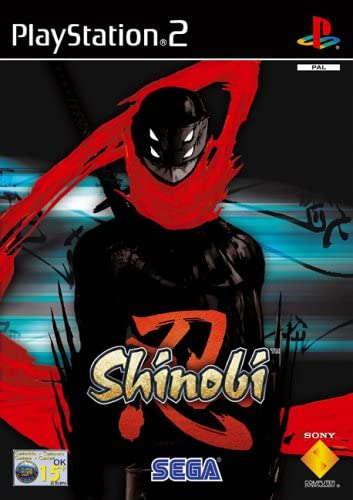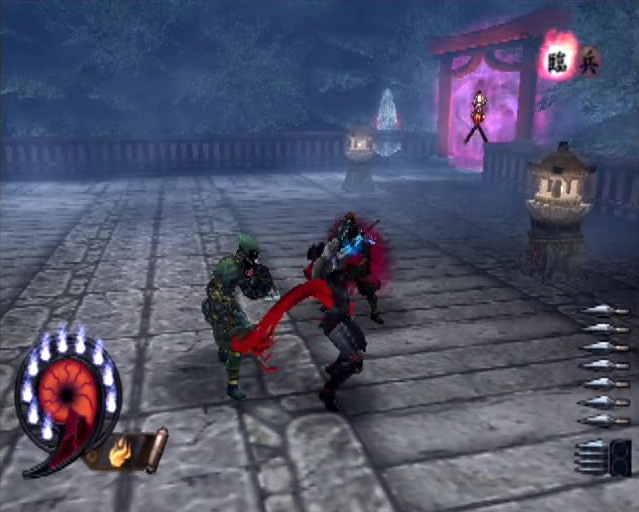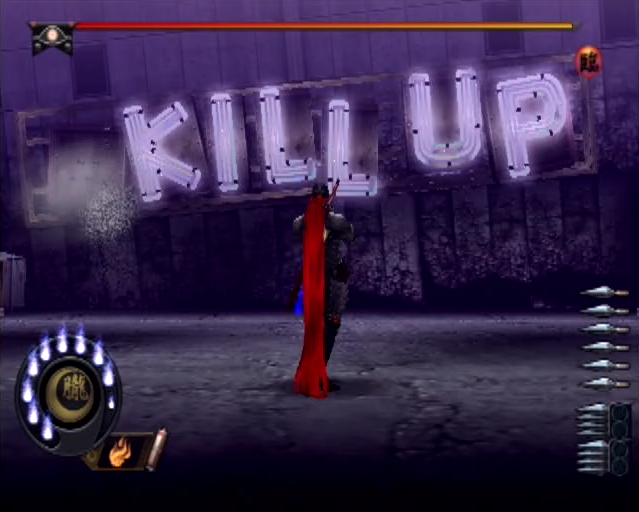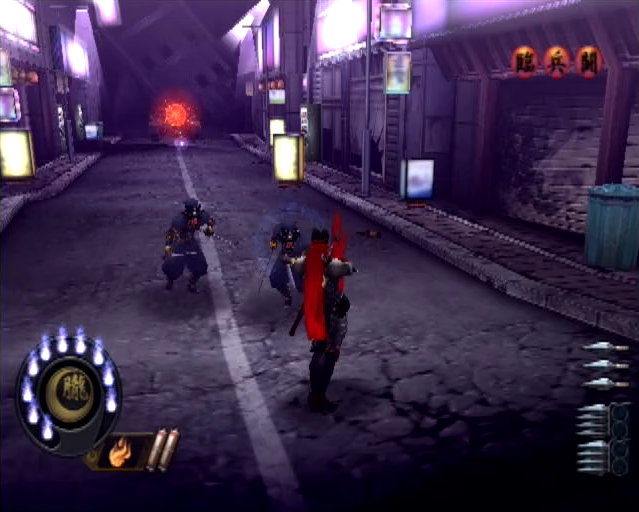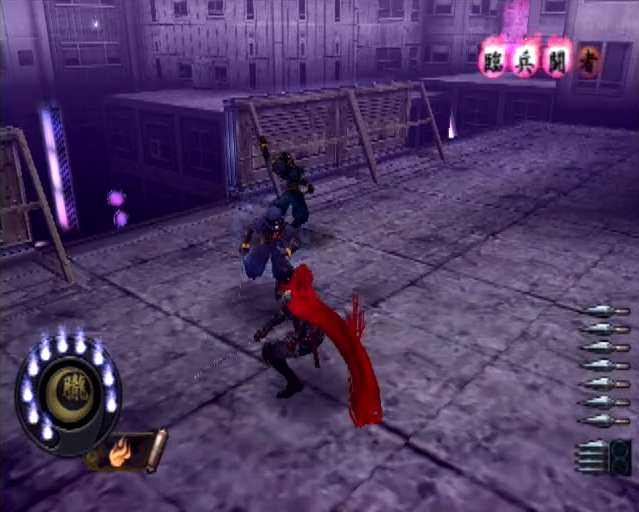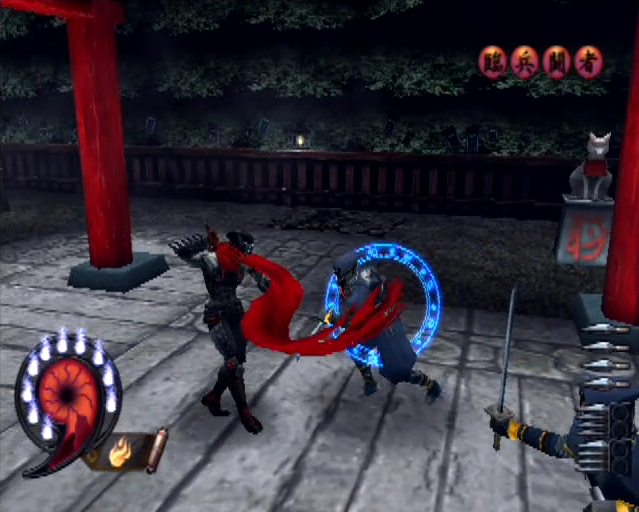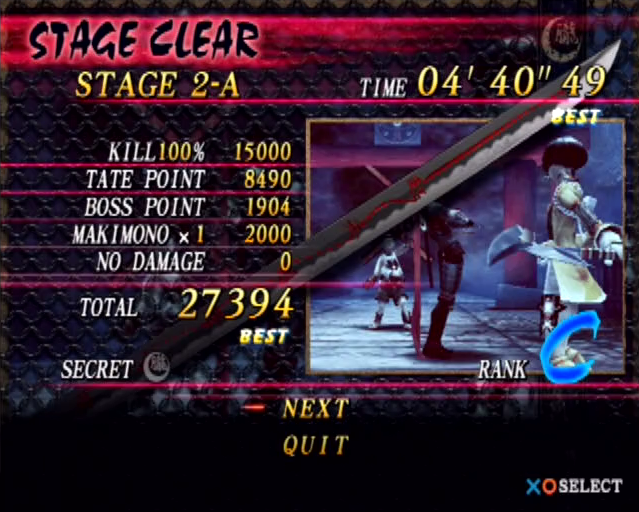SHINOBI (PS2)
Once the Dreamcast was discontinued in 2001, many games in development would end up migrating to other platforms as SEGA transitioned into a third-party publisher and developer. The Xbox would see Jet Set Radio Future, the GameCube would get Super Monkey Ball and the PS2 would be gifted with hack ‘n’ slash reboot Shinobi. From the talented team behind Skies of Arcadia, this 3D reimagining is a great example of how to revive a classic series, with searing difficulty, stylish action and replayability to spare. Those who are not scared off by its high level of challenge will be rewarded.
After Tokyo is decimated by an earthquake, a mysterious Golden Palace appears in the middle of the ruined city. As an ancient sorcerer begins to summon demonic hellspawn to wreak havoc, it’s up to Hotsuma, the last of his Oboro clan, to save the city while exacting his revenge. But when the ghosts of his past begin to resurface, along with the awakening of the corrupted Akujiki sword that drains Hotsuma of his life force, his mission is far from easy.
It's a race against time to keep Hotsuma's blood-thirsty sword satisfied
At its core a hack ‘n’ slasher, Shinobi seems relatively basic at first glance. Hotsuma comes equipped only with a single weapon, and aside from throwing shurikens to stun, there’s not much else to it. It makes up for its simplicity with a significant degree of challenge. Your sword, the Akujiki, continually drains as you play. If its thirst for demonic blood is not quenched, the sword will eventually begin to drain your life. This lends a breathless urgency to the combat, as you frantically attempt to keep the sword from reducing your health. With enemies dealing enough damage as it is, it can be very hard to grasp Shinobi’s frantic combat system.
Though it’s hard to master, it’s a system that can be conquered, with perseverance. You soon discover the combo system known as Tate. When there are multiple enemies in the vicinity, killing one of them will freeze them temporarily before they die. This allows you to kill more enemies, with your sword charging in rapid succession. Once you’ve killed all the enemies, Hotsuma decapitates them. It’s a cool moment, but also a strategically useful one. Enemies come in many shapes and sizes and while larger foes are usually harder to slay, the Tate system allows you to charge your sword and deal more damage. In other words, you can prioritise smaller and easier enemies to reduce the ordeal of fighting the larger ones. It’s surprisingly deep and stylish all the same.
Though it’s hard to master, it’s a system that can be conquered, with perseverance. You soon discover the combo system known as Tate. When there are multiple enemies in the vicinity, killing one of them will freeze them temporarily before they die. This allows you to kill more enemies, with your sword charging in rapid succession. Once you’ve killed all the enemies, Hotsuma decapitates them. It’s a cool moment, but also a strategically useful one. Enemies come in many shapes and sizes and while larger foes are usually harder to slay, the Tate system allows you to charge your sword and deal more damage. In other words, you can prioritise smaller and easier enemies to reduce the ordeal of fighting the larger ones. It’s surprisingly deep and stylish all the same.
The game isn’t perfect, though. A tight camera does not present much of an issue during combat, but it can hamper platforming. Hotsuma can jump and attach to certain walls, and while this move has a certain flair to it, it can be hard to see where you’re going before you leap. This is further complicated by flying enemies often encountered in tandem with precise platforming, leading to some of the harder segments in the game which, sadly, aren’t as fair. The level design can also feel a bit vapid. Levels often lack any sense of evolution, leading to some samey looking environments.
The highlight of each level usually comes at the end, as Hotsuma enters an encounter with a boss. These are creative affairs, including possessed attack helicopters, mythical creatures and skilled warriors that are more intimate fights. They also make fantastic use of the Tate system, with strategy and thought required rather than mindless button mashing. Taking out these harder adversaries with a single motion of a charged up Tate manoeuvre is perhaps one of the most satisfying moments in the series.
Shinobi has four difficulty levels, all of which acting as a stern test to the player. Easy is mostly manageable for those who can grasp the combat mechanics, but even then a couple of the bosses are tough. Normal ups the ante significantly, as Hotsuma takes more damage and it also introducing new hazards, such as more enemies and changing water levels on particular stages. From there, Hard and Super can be unlocked by completing each successive difficulty. These are not for the faint-hearted: Super offers one of the most difficult modes in any game, period. But these challenges, combined with dozens of hidden secrets and unlockable bonuses, lend Shinobi a lot of replay value. You just have to become good enough to experience them!
The highlight of each level usually comes at the end, as Hotsuma enters an encounter with a boss. These are creative affairs, including possessed attack helicopters, mythical creatures and skilled warriors that are more intimate fights. They also make fantastic use of the Tate system, with strategy and thought required rather than mindless button mashing. Taking out these harder adversaries with a single motion of a charged up Tate manoeuvre is perhaps one of the most satisfying moments in the series.
Shinobi has four difficulty levels, all of which acting as a stern test to the player. Easy is mostly manageable for those who can grasp the combat mechanics, but even then a couple of the bosses are tough. Normal ups the ante significantly, as Hotsuma takes more damage and it also introducing new hazards, such as more enemies and changing water levels on particular stages. From there, Hard and Super can be unlocked by completing each successive difficulty. These are not for the faint-hearted: Super offers one of the most difficult modes in any game, period. But these challenges, combined with dozens of hidden secrets and unlockable bonuses, lend Shinobi a lot of replay value. You just have to become good enough to experience them!
Speed, style and tactics are all rewarded in Shinobi, with a number of tough boss battles to overcome
Despite demonstrating some bland level layouts, it’s a decent looking game. Importantly, it runs at a smooth frame rate, keeping the action fast and flowing. Hotsuma himself is nicely designed: his bright-red scarf shadows his movements, flowing freely as he runs, which is a neat effect. The monsters have a few variants and at least alter between stages with palette changes. The visuals can come off a touch drab at times, but they make up for it with speed and fluidity. The sound is decent, with some particularly catchy music which feels like a homage to more retro music. The sounds, such as the growl when hellspawn emerge and the slice after a Tate, are forceful. Meanwhile, the voice acting is fairly plain, but not offensively bad either.
Shinobi makes gameplay its priority and while the presentation can come off as a touch drab, the fast, furious combat is extremely satisfying. It’s certainly not for less serious gamers, as its punishing difficulty scared many players away at the time of its release. While it can sometimes feel cheap due to wonky platforming, the combat is so fluid and satisfying that these flaws feel minuscule. If you’re looking for a challenging, satisfying ode to games of old, then Shinobi will punch that ticket with no mercy.
Shinobi makes gameplay its priority and while the presentation can come off as a touch drab, the fast, furious combat is extremely satisfying. It’s certainly not for less serious gamers, as its punishing difficulty scared many players away at the time of its release. While it can sometimes feel cheap due to wonky platforming, the combat is so fluid and satisfying that these flaws feel minuscule. If you’re looking for a challenging, satisfying ode to games of old, then Shinobi will punch that ticket with no mercy.
|
|
VERDICT
"Stylish and surprisingly deep... Shinobi makes the gameplay its priority and while its presentation can come off as a touch drab, its fast, furious combat is extremely satisfying." OVERALL: 8/10 |
